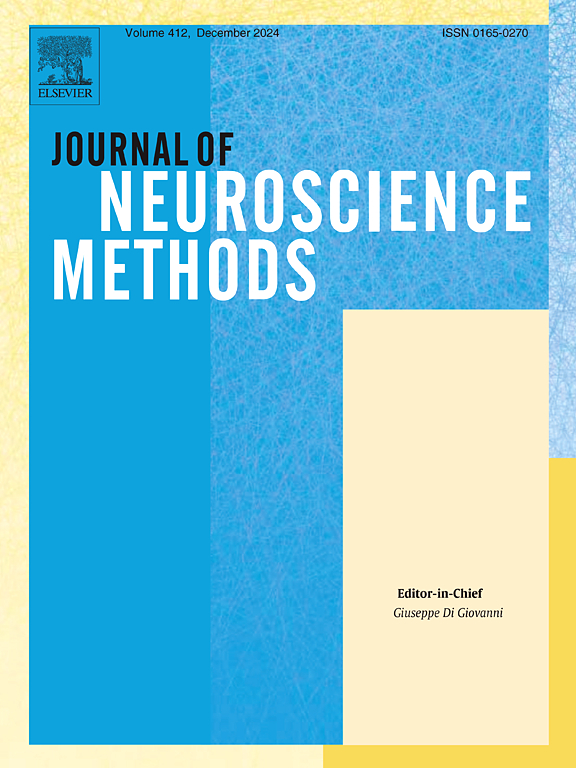Spinal cord trunk preparation for analyzing cross-segmental primary afferent signal transmission and modulation
IF 2.7
4区 医学
Q2 BIOCHEMICAL RESEARCH METHODS
引用次数: 0
Abstract
Background
The spinal cord dorsal horn is pivotal for primary afferent signal transmission and modulation. Primary afferent fibers from each dorsal root arrive at the dorsal horn and travel 1–2 segments caudally and rostrally. Usually, in vitro spinal cord slices or in vivo preparations are employed for primary afferent stimulation and patch-clamp recordings to assess input signals. However, the spinal cord slices lose "intact" cross-segmental pathways, and in vivo studies are technically challenging.
New method
Here, we describe the preparation of a spinal cord trunk for analyzing afferent signal cross-segmental transmission in adult rats. By combining patch-clamp recording, Lissauer's tract stimulation, and ambient temperature manipulation, our methods enable accessing primary afferent pathways within several segments.
Results
Our present spinal trunk preparation can be maintained healthy for about 5 h. Lissauer’s tract stimulation induced evoked excitatory postsynaptic currents (eEPSCs) recorded in 6–10 mm rostrally in the ipsilateral dorsal horn. The eEPSCs, spontaneous EPSCs (sEPSCs), and neural excitability can be modulated by ambient temperature rise. Neuropharmacological studies can also be conducted on this spinal trunk preparation.
Compared with existing methods
Compared with conventional in vitro spinal cord slices, our present method maintains a relatively intact cross-segment pathway in the dorsal horn; compared with in vivo study, it avoids mechanical vibration and other technical challenges in living animals.
Conclusion
The rodent spinal cord trunk can be maintained for an extended period in a fully submerged chamber; combined with patch clamp recordings, our protocol facilitates the study of primary afferent transmission and modulation in the dorsal horn within adjacent segments.
脊髓干准备分析跨节段初级传入信号的传输和调制
脊髓背角对初级传入信号的传递和调制起关键作用。各背根的初级传入纤维到达背角,沿尾侧和喙侧行进1-2节。通常,体外脊髓切片或体内制剂用于初级传入刺激和膜片钳记录以评估输入信号。然而,脊髓切片失去了“完整的”跨节段通路,体内研究在技术上具有挑战性。新方法在此,我们描述了用于分析成年大鼠传入信号跨节段传递的脊髓干的制备。通过结合膜片钳记录、利索耳束刺激和环境温度操纵,我们的方法能够访问几个片段内的主要传入通路。结果本实验制备的脊髓干可保持健康5 h左右。利索道刺激诱发的兴奋性突触后电流(eEPSCs)记录在同侧背角背侧6-10 mm。EPSCs、自发EPSCs (sEPSCs)和神经兴奋性可以通过环境温度升高来调节。神经药理学研究也可以对这种脊髓干制剂进行。与传统的体外脊髓切片相比,我们的方法在脊髓背角中保持了相对完整的横段通路;与体内研究相比,它避免了活体动物的机械振动和其他技术挑战。结论鼠类脊髓干在全浸没腔中可长时间保持;结合膜片钳记录,我们的协议有助于研究相邻段内背角的主要传入传输和调制。
本文章由计算机程序翻译,如有差异,请以英文原文为准。
求助全文
约1分钟内获得全文
求助全文
来源期刊

Journal of Neuroscience Methods
医学-神经科学
CiteScore
7.10
自引率
3.30%
发文量
226
审稿时长
52 days
期刊介绍:
The Journal of Neuroscience Methods publishes papers that describe new methods that are specifically for neuroscience research conducted in invertebrates, vertebrates or in man. Major methodological improvements or important refinements of established neuroscience methods are also considered for publication. The Journal''s Scope includes all aspects of contemporary neuroscience research, including anatomical, behavioural, biochemical, cellular, computational, molecular, invasive and non-invasive imaging, optogenetic, and physiological research investigations.
 求助内容:
求助内容: 应助结果提醒方式:
应助结果提醒方式:


